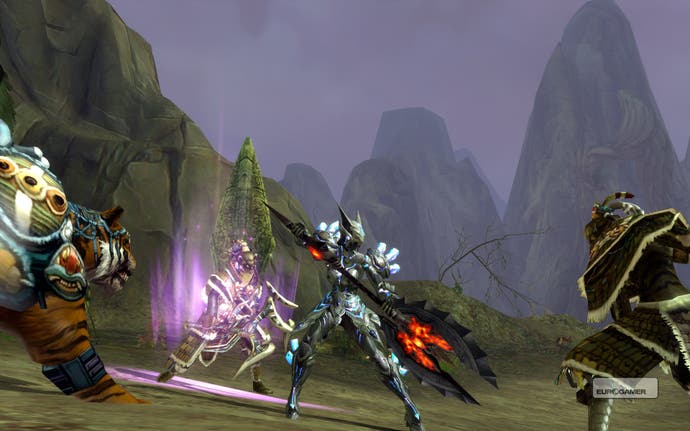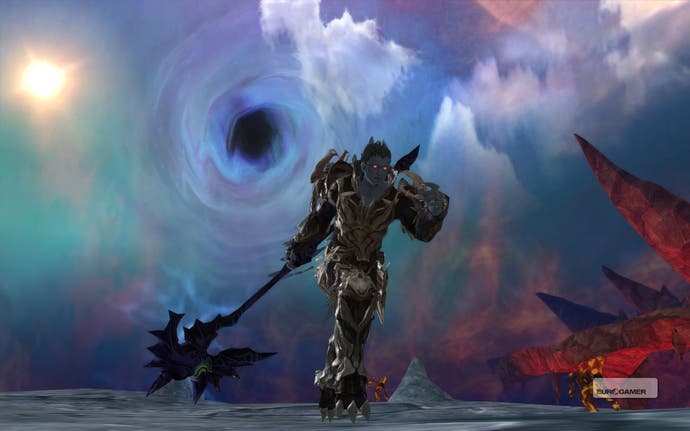Aion: The Tower of Eternity
From here to eternity?
2, 2, 3, 3, 5, 2, 3, 4, 5.
After a week playing a Chanter in the open beta for Aion: The Tower of Eternity, NCsoft's new MMO, this sequence of key-presses is hard-coded into the muscle memory my left hand. I can tap it out on a table-top, the rhythm steady, urgent yet patient, hitting every skill's cooldown on the nose. Not a second or a mana point wasted. 2, 2, 3, 3, 5, 2, 3, 4, 5.
I used this same stone-set sequence to defeat almost every monster I fought between the levels of 10 and 20. There might be slight variations depending on range, or if I'd made a terrible mistake and found myself fighting two enemies at once - but usually, the circumstances of every one-minute combat in the thousands of them I undertook would be exactly the same, because I'd make sure they were. Anything else would be sub-optimal. Anything else would risk dislodging me from the locked-down groove of the grind.
NCsoft has made much of its herculean effort to create, in Aion, an MMO that could appeal to both its Asian heartlands and the WOW-addled masses of the West. Although it was made in South Korea, it was designed with one eye on the Occident from the start, and since its Korean release it has undergone almost a year of additional "culturalisation": tweaking, testing, translating, adding features and content.
However, it turns out that you can take the MMO out of Korea, but you can't entirely take Korea out of the MMO. Like its predecessors the Lineage games, Aion is predominantly about grind. Hypnotic, repetitive, epic grind. It's just that Aion elevates grind to an art form, and handsomely mounts it in a gilt-edged frame.

This is a deeply traditional massively multiplayer RPG that's been tuned and oiled and lathed down to a perfect, stress-tested, smooth-running efficiency. It's beautiful and flawlessly easy to use. It does everything you expect and nothing you don't - until halfway through its 50 levels, at least. That's when you make your first steps in its central war zone, the Abyss, and things start to get more interesting.
But due to the brief windows and restricted level caps NCsoft has employed in Aion's closed and open beta testing, it hasn't been possible to get a full picture of the Abyss yet - and it won't be for some time after the game's launch this week. Even if you were lucky and dedicated enough to level that far, you were pretty lonely, and the Abyss - which pits the game's two player factions against each other and a third, computer-controlled faction - will only come into its own with enough sufficiently high-level and well-organised players about.
However, we do know a fair bit about it - from the game's Korean launch and from what NCsoft has already said - and that informs this review. We'll return to look at it in more detail in a future re-review.

For a starting player, however, the Abyss is almost irrelevant, because there are dozens of hours of straight-laced questing - and not a great deal else - between you and it. You won't even see the inside of a dungeon, never mind a player from another faction, before level 25. You'll be on your own or grouped with up to five others, running around attractive, slightly surreal fantasy locations, smashing charismatic monsters in the face and occasionally pausing to craft, trade and socialise in Aion's expansive cities.
You'll play as either and Elyos or Asmodian, humanoid races who each occupy one half of Aion's shattered, outside-in planet, Atreia. The Elyos inhabit the sun-blessed half while the grey-skinned Asmodians live in permanent twilight, and have claws and manes - but otherwise, the experience is much the same.
In the classic Korean style, both races are designed to be swoonsome waifs and shampoo hunks by default, but NCsoft has expanded the character customisation parameters considerably for the Western release. A little too much, perhaps. Many players end up looking like catalogue models in a hall of mirrors, with super-deformed, gangling giants and ridiculous midgets skittering around. It makes for an odd clash with the languorous lushness and Gothic majesty of the rest of the game's art, but it is quite funny.


